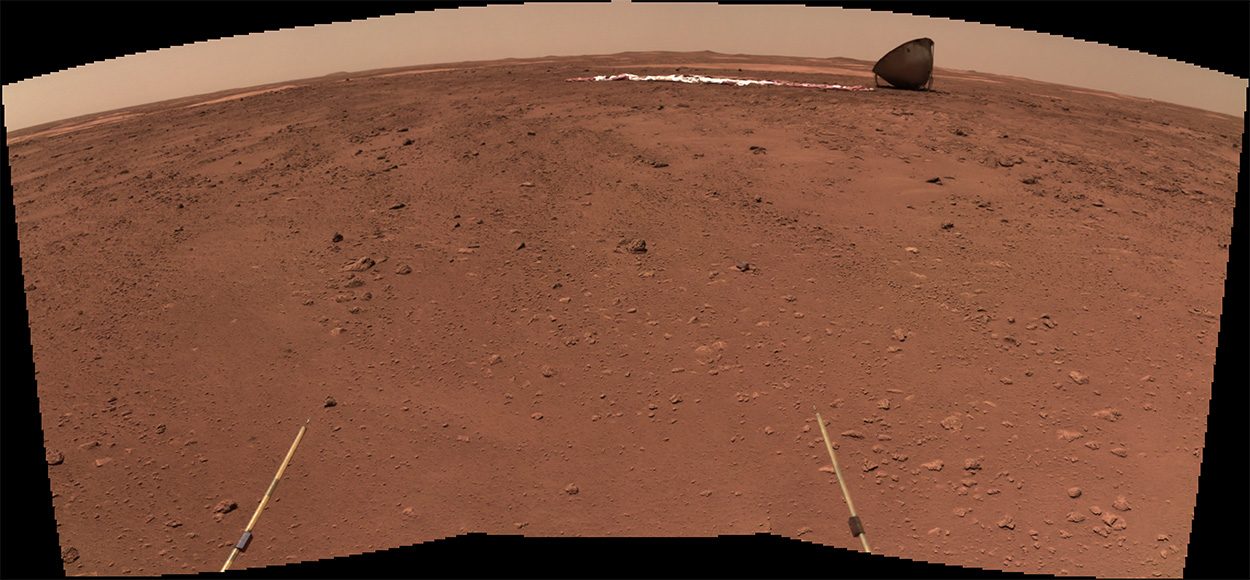So far it is not clear how long the life span on Mars lasted and how long there is still liquid water. The Chinese Mars rover Zhurong is now providing exciting data in this regard. Because his analyzes of rock samples south of the Great Depression Utopia Planitia indicate that there was still water at or below the surface in the younger age of the planet. The researchers see evidence of this as evidence of silicates and hydrated sulfates, which must have formed in the Amazon era, which began about 1.8 billion years ago. In their view, this could indicate that liquid water has been present, at least intermittently, on the Red Planet for longer than previously thought.
Our neighboring planet Mars may have been much warmer and more livable in its early days than it is today. Common assumptions at the time were that the atmosphere, lakes and rivers are denser and, according to some researchers, perhaps even the ocean. To date, however, there is debate about how much liquid water was actually present at that time as well as how long it remained. Because after an earlier, milder period, the Red Planet’s climate changed and lost large parts of its atmosphere, becoming cooler and drier. At least at the beginning of the Amazonian period about 1.8 billion years ago, but perhaps at the beginning of the Martian Hesperian period 3.5 billion years ago, there was no longer any permanent presence of liquid water on the surface of Mars. Today, water on Mars exists only in the form of water ice, which is found, among other things, in the polar ice caps and in the remains of underground glaciers. There is debate as to whether there is still water in the form of a highly saline liquid under the surface of Mars.
Rover examining rocks in Utopia Planetia
But what about the temporary appearance of liquid water at least? According to some hypotheses, even in the cold, dry modern era of Mars, water from hydrothermal vents or other heated groundwater sources could have appeared at the surface at least occasionally. “Recent analyzes have identified riverine terrain that cuts through the Amazon terrain,” explain Yang Liu of the National Aerospace Research Center in Beijing and colleagues. “This indicates that even the most recent era of Mars still shows water activity that shaped the surface.” , was to provide, among other things, the Chinese Tianwen-1 mission to Mars, which shot down the Zhurong rover in May 2021 in the south of the country. Plain Utopia Planitia.
Equipped with six different science instruments, the rover has spent 92 days of its mission studying morphology, mineralogy, surface structure and ice distribution around the landing site in the largest impact basin on Mars. The data that Liu and his team analyzed now show that there are two different types of rock in this part of Utopia Planitia. The team explains that the former includes darker basalt rocks believed to come from older and deeper layers. On the other hand, the second type of rock is mostly light in color, and the light-colored substance sometimes forms a coating on the dark interior. “These pieces are covered in dust and often show crusting or scaly surfaces indicative of physical weathering from heat and wind stress,” the researchers report. From investigations and geological conditions, they concluded that these pieces must have come from the Amazonian period.
Wet mineral scales indicate the presence of water pores
Careful analysis of the shiny rocks using various spectrophotometers has shown that these pieces contain hydrated minerals – minerals that have water bound in their structure and typically form on Earth in the presence of liquid water. According to Liu and colleagues, the spectral fingerprints of the Martian rocks can match those of hydrated silicates and sulfates, as well as gypsum. Looking at the layers of light that partially formed around the dark cores, they assume that it is a kind of hard crust – hard crusts formed by the deposition of minerals from the porous waters of rocks. In the case of Mars’ crusts, researchers believe they formed when brine rose underground during phases of rising groundwater levels. Then the salty mineral crusts formed as evaporation from the near surface increased the salinity of this porous water.
According to scientists, the presence of these mineral crusts indicates that there is still enough groundwater in the Amazon period to temporarily absorb the nearby topsoil resulting in the formation of durable crusts. “These observations indicate that water activity on Mars has persisted for much longer than previously thought,” Liu and his team wrote. They see volcanic activity as well as vibration of Mars’ axis as possible reasons for the accidental emergence of underground liquid water. Since this has repeatedly changed direction by more than a dozen degrees over the course of Mars’ history, a somewhat milder climate may have prevailed in southern Utopia Planitia and other regions, at least temporarily.
However, the new findings also have potential implications for future Mars missions: “The Zhurong landing site and other areas of the Northern Plains may contain large amounts of usable water in the form of wet minerals and subsurface ice, which will be used by future Mars exploration. As a pro-resource location,” the research team confirms.
Source: Yang Liu (National Center for Space Science, Chinese Academy of Sciences, Beijing) et al., Science Advances, doi: 10.1126/sciadv.abn8555

“Alcohol buff. Troublemaker. Introvert. Student. Social media lover. Web ninja. Bacon fan. Reader.”







More Stories
Newly appointed Science, Research and Innovation Council
Asparagus with Salmon and Avocado: A slightly different asparagus dish
Intelligence and Alzheimer's disease: How fit is your brain? Your eyes guide her